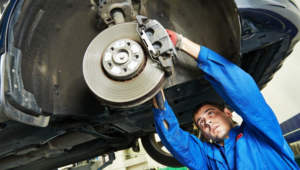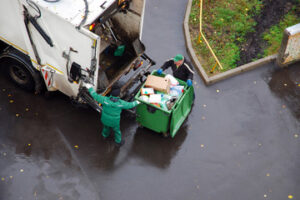It doesn’t take a rocket scientist to figure out that roof repair is not a good idea during howling winds, torrential rains or an incoming blizzard. It also doesn’t take a rocket scientist to understand that working on your roof should be left to professionals with the right gear and safety training.

Your roof’s shingles and tiles are your first line of defense against rain, hail, and snow. When they are damaged, they leave your home vulnerable to leaks and other problems. Shingle damage can occur for a variety of reasons, including weather, poor installation, and age. Identifying and repairing shingle damage promptly is essential to prevent it from worsening.
Missing shingles, cracks, and curling shingles are all signs of roof damage that should be addressed immediately. If left unattended, these issues can lead to structural damage, water leaks, and mold growth.
While a roof with shingles is the most common type of roofing material, tile and metal roofs are also popular options for homes. These roofs are more durable than shingle roofs, but they may require more frequent repairs than shingle roofs due to their construction. Regardless of the type of roofing material, all roofs need regular maintenance to maintain their integrity.
Start by locating the source of the leak. Look for damp spots on the ceiling and walls, and trace the moisture back to the source. You might need to remove a section of the shingles to access the area and repair it.
Once you’ve located the damaged shingle, slide your flat pry bar underneath and run it along the edge of the shingle to break the glue seal. Lift the shingle gently and carefully, so that you don’t tear any undamaged shingles. Once you’ve removed the shingle, use your nail set to remove the nails that held it in place. If any nails are exposed, cover them with roof cement.
If the shingle is torn, you’ll need to replace it. To do so, locate the row of shingles above the damaged section and peel back a layer with your pry bar. Carefully work your way around the shingle layer, exposing each nail and pulling them loose as you go. Continue this process until you expose the row of nails above the damaged shingle and remove those nails as well.
Next, lay a new 3-tab shingle in place and fasten it with the roofing nails. If you’re not comfortable working on top of your roof, you can purchase a tarp kit and lay it over the damaged area to protect it until a licensed roofer can perform a permanent repair.
Leaks
Your roof is a critical part of your home, protecting you and your belongings from the elements outside. If you have a leak, it can cause water damage and create a host of other problems in your home. The first step in preventing leaks is to locate the source.
Leaks often start around penetrations such as plumbing and roof vents, chimneys, dormers and skylights. You can check the area by removing any items in that area and looking at the ceiling underneath. Look for water stains and sagging spots, as these are signs that there is a problem in the ceiling.
Once you have located the source, it is time to get to work on repairing it. If it is a small leak, you can caulk the hole and stop it from getting worse. If it is a bigger issue, you should replace the damaged section of the roof or, in some cases, the entire roof.
You should also inspect your attic periodically for signs of leaks. If you have access to the attic, you can use a ladder to look at the ceiling and roof for problems such as missing shingles or flashing issues. If you are unable to access the attic, you can use binoculars or even a drone to get close-up photos and video footage of the roof.
Another way to find a leak is to run a garden hose up on the roof. Start low, and systematically soak areas above where the leak appears in the house. You should be able to find the source quickly this way. Leaks sometimes occur along the valleys of your roof, where two slopes meet. This is typically caused by missing shingle material or a poor seal, which allows water to seep into your home.
Other common sources of leaks are clogged gutters that allow water to wash over the lower sections of your roof, or excess moisture from poorly installed upper roof gutters that can saturate the ceiling below. Regular maintenance, including cleaning and repairing gutters, can help prevent these types of leaks.
Damaged Flashing
Although roof flashing helps to protect areas where the roof meets other elements, it is not impervious to damage and wear. Failed flashing is one of the most common causes of roof leaks, and it can lead to costly water damage inside a home. Flashing is often made of galvanized steel, but it can rust or degrade over time. It can also be damaged by the freeze-thaw cycle that northern homes experience during winter, where freezing water expands and erodes the flashing material.
You can spot flashing by the metal trim sealed with caulk around penetrations on your roof, such as chimneys, skylights, dormers and roof vents. It is also found along the eaves and at the rake edges of your roof. Flashing can be found on flat roofs as well, but it will usually be coated with a roofing membrane to add extra protection against water infiltration.
While many homeowners do attempt DIY roof repairs, flashing is a job for the professionals. Flashing repair can be complex and requires a great deal of knowledge to complete correctly. Using temporary methods like roof flashing tape to cover cracks and holes in your flashing can provide some weatherproofing, but it is not as reliable as permanent repairs. If you notice a large gap or crack in your roof flashing, contact your local roofing contractor to schedule repairs immediately.
Water leaks are serious and can cause extensive structural damage in your home, including the foundation. Water can also seep into the insulation and wood framing, and can lead to rot or mold. If left untreated, a leak can even deteriorate the wood and structure of your home.
Luckily, there are some preventative measures you can take to avoid flashing problems in the first place. Make sure your gutters are clear of debris to prevent water pooling in or over the flashing, and trim overhanging tree branches that can rub against and damage it. You should also inspect your roof for signs of rust or corrosion, and keep an eye out for gaps or cracks in the flashing.
Damaged Gutters
Gutters are more than just a cosmetic component of your roof. They play a crucial role in keeping your house safe and dry, as well as protecting its value. Damaged gutters cause problems that can be quite severe, including basement flooding, shingle rot and landscape erosion. Fortunately, many of these problems can be prevented with routine cleaning and repair by a qualified roof repair service.
The most common reason for gutter damage is clogging from leaves, twigs, seeds and other debris that accumulate in the gutter over time. A damaged gutter cannot properly direct water from the roof to the downspouts, causing the flow of rainwater to become blocked and eventually overflowing into the home.
Clogged gutters can also be a source of moisture that seeps into the fascia board, which can lead to wood rot. This can also create a breeding ground for mold that can affect the health of you and your family.
Another frequent problem with gutters is corrosion. Rust eats through metal gutters, making them weak and prone to failure. Corrosion can also reduce the value of your home and make it look less attractive, especially if the corrosion is visible from the street.
If you notice that your gutters are rusting or have holes, you can repair them easily with roof and gutter sealant. Start by cleaning the area and removing any loose paint or rust. Then, buy a tube of roof and gutter sealant and a metal repair patch that matches your gutters (you may need to use tin snips or a saw to cut a new section). Apply the patch by putting a thin layer of cement on the inside of the gutter where the hole is located. Press the patch down into the gutter, and then apply a second thin layer of cement over the top of the gutter.
Gutter damage is usually due to a lack of regular maintenance, but it can also be caused by a heavy downpour that causes the gutters to overflow and pull away from the home. The best way to prevent these problems is to have your gutters inspected and repaired regularly, and to have trees that overhang your house pruned to avoid the need for gutter repairs or replacement.








